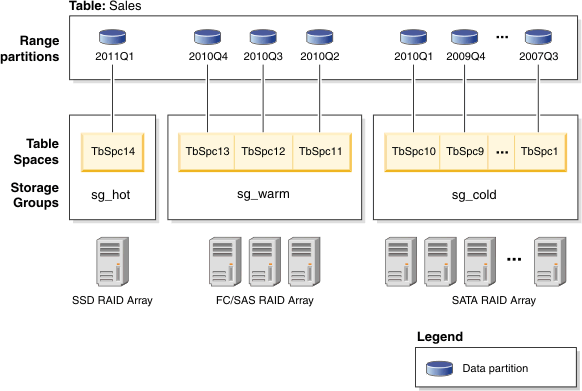You can configure your databases so that frequently accessed data (hot data) is stored on fast storage, infrequently accessed data (warm data) is stored on slightly slower storage, and rarely accessed data (cold data) is stored on slow, less-expensive storage. As hot data cools down and is accessed less frequently, you can dynamically move it to the slower storage.
In database systems, there is a strong tendency for a relatively small proportion of data to be hot data and the majority of the data to be warm or cold data. These sets of multi-temperature data pose considerable challenges if you want to optimize the use of fast storage by trying not to store cold data there. As a data warehouse consumes increasing amounts of storage, optimizing the use of fast storage becomes increasingly important in managing storage costs.
Storage groups are groups of storage paths with similar qualities. Some critical attributes of the underlying storage to consider when creating or altering a storage group are available storage capacity, latency, data transfer rates, and the degree of RAID protection. You can create storage groups that map to different classes of storage in your database management system. You can assign automatic storage table spaces to these storage groups, based on which table spaces have hot, warm, or cold data. To convert database-managed table spaces to use automatic storage, you must issue an ALTER TABLESPACE statement specifying the MANAGED BY AUTOMATIC STORAGE option and then perform a rebalance operation.
Because current data is often considered to be hot data, it typically becomes warm and then cold as it ages. You can dynamically reassign a table space to a different storage group by using the ALTER TABLESPACE statement, with the USING STOGROUP option.
You can do all this work while the database is online.

The following steps provide more details on how to set up multi-temperature data storage for the sales data in the current fiscal year:
CREATE STOGROUP sg_hot ON '/ssd/path1', '/ssd/path2' DEVICE READ RATE 100
OVERHEAD 6.725;
CREATE STOGROUP sg_warm ON '/hdd/path1', '/hdd/path2';These statements define an SSD storage group (sg_hot) to store hot data and an FC and SAS storage group (sg_warm) to store warm data.
CREATE TABLESPACE tbsp_2010q2 USING STOGROUP sg_warm;
CREATE TABLESPACE tbsp_2010q3 USING STOGROUP sg_warm;
CREATE TABLESPACE tbsp_2010q4 USING STOGROUP sg_warm;
CREATE TABLESPACE tbsp_2011q1 USING STOGROUP sg_hot;CREATE TABLE sales (order_date DATE, order_id INT, cust_id BIGINT)
PARTITION BY RANGE (order_date)
(PART "2010Q2" STARTING ('2010-04-01') ENDING ('2010-06-30') in "tbsp_2010q2",
PART "2010Q3" STARTING ('2010-07-01') ENDING ('2010-09-30') in "tbsp_2010q3",
PART "2010Q4" STARTING ('2010-10-01') ENDING ('2010-12-31') in "tbsp_2010q4",
PART "2011Q1" STARTING ('2011-01-01') ENDING ('2011-03-31') in "tbsp_2011q1"); CREATE TABLESPACE tbsp_2011q2 USING STOGROUP sg_hot;ALTER TABLESPACE tbsp_2011q1 USING STOGROUP sg_warm;